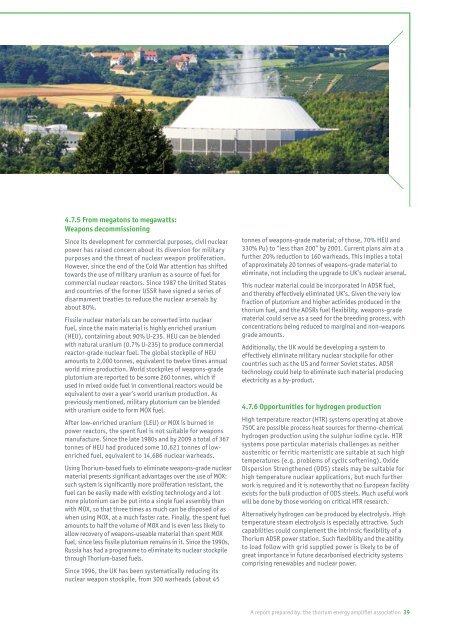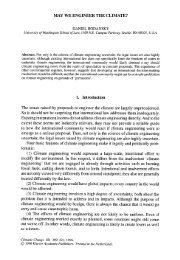ThorEA - Towards an Alternative Nuclear Future.pdf
ThorEA - Towards an Alternative Nuclear Future.pdf
ThorEA - Towards an Alternative Nuclear Future.pdf
Create successful ePaper yourself
Turn your PDF publications into a flip-book with our unique Google optimized e-Paper software.
4.7.5 From megatons to megawatts:<br />
Weapons decommissioning<br />
Since its development for commercial purposes, civil nuclear<br />
power has raised concern about its diversion for military<br />
purposes <strong>an</strong>d the threat of nuclear weapon proliferation.<br />
However, since the end of the Cold War attention has shifted<br />
towards the use of military ur<strong>an</strong>ium as a source of fuel for<br />
commercial nuclear reactors. Since 1987 the United States<br />
<strong>an</strong>d countries of the former USSR have signed a series of<br />
disarmament treaties to reduce the nuclear arsenals by<br />
about 80%.<br />
Fissile nuclear materials c<strong>an</strong> be converted into nuclear<br />
fuel, since the main material is highly enriched ur<strong>an</strong>ium<br />
(HEU), containing about 90% U-235. HEU c<strong>an</strong> be blended<br />
with natural ur<strong>an</strong>ium (0.7% U-235) to produce commercial<br />
reactor-grade nuclear fuel. The global stockpile of HEU<br />
amounts to 2,000 tonnes, equivalent to twelve times <strong>an</strong>nual<br />
world mine production. World stockpiles of weapons-grade<br />
plutonium are reported to be some 260 tonnes, which if<br />
used in mixed oxide fuel in conventional reactors would be<br />
equivalent to over a year’s world ur<strong>an</strong>ium production. As<br />
previously mentioned, military plutonium c<strong>an</strong> be blended<br />
with ur<strong>an</strong>ium oxide to form MOX fuel.<br />
After low-enriched ur<strong>an</strong>ium (LEU) or MOX is burned in<br />
power reactors, the spent fuel is not suitable for weapons<br />
m<strong>an</strong>ufacture. Since the late 1980s <strong>an</strong>d by 2009 a total of 367<br />
tonnes of HEU had produced some 10,621 tonnes of lowenriched<br />
fuel, equivalent to 14,686 nuclear warheads.<br />
Using Thorium-based fuels to eliminate weapons-grade nuclear<br />
material presents signific<strong>an</strong>t adv<strong>an</strong>tages over the use of MOX:<br />
such system is signific<strong>an</strong>tly more proliferation resist<strong>an</strong>t, the<br />
fuel c<strong>an</strong> be easily made with existing technology <strong>an</strong>d a lot<br />
more plutonium c<strong>an</strong> be put into a single fuel assembly th<strong>an</strong><br />
with MOX, so that three times as much c<strong>an</strong> be disposed of as<br />
when using MOX, at a much faster rate. Finally, the spent fuel<br />
amounts to half the volume of MOX <strong>an</strong>d is even less likely to<br />
allow recovery of weapons-useable material th<strong>an</strong> spent MOX<br />
fuel, since less fissile plutonium remains in it. Since the 1990s,<br />
Russia has had a programme to eliminate its nuclear stockpile<br />
through Thorium-based fuels.<br />
Since 1996, the UK has been systematically reducing its<br />
nuclear weapon stockpile, from 300 warheads (about 45<br />
tonnes of weapons-grade material; of those, 70% HEU <strong>an</strong>d<br />
330% Pu) to “less th<strong>an</strong> 200” by 2001. Current pl<strong>an</strong>s aim at a<br />
further 20% reduction to 160 warheads. This implies a total<br />
of approximately 20 tonnes of weapons-grade material to<br />
eliminate, not including the upgrade to UK’s nuclear arsenal.<br />
This nuclear material could be incorporated in ADSR fuel,<br />
<strong>an</strong>d thereby effectively eliminated UK’s. Given the very low<br />
fraction of plutonium <strong>an</strong>d higher actinides produced in the<br />
thorium fuel, <strong>an</strong>d the ADSRs fuel flexibility, weapons-grade<br />
material could serve as a seed for the breeding process, with<br />
concentrations being reduced to marginal <strong>an</strong>d non-weapons<br />
grade amounts.<br />
Additionally, the UK would be developing a system to<br />
effectively eliminate military nuclear stockpile for other<br />
countries such as the US <strong>an</strong>d former Soviet states. ADSR<br />
technology could help to eliminate such material producing<br />
electricity as a by-product.<br />
4.7.6 Opportunities for hydrogen production<br />
High temperature reactor (HTR) systems operating at above<br />
750C are possible process heat sources for thermo-chemical<br />
hydrogen production using the sulphur iodine cycle. HTR<br />
systems pose particular materials challenges as neither<br />
austenitic or ferritic martenistic are suitable at such high<br />
temperatures (e.g. problems of cyclic softening). Oxide<br />
Dispersion Strengthened (ODS) steels may be suitable for<br />
high temperature nuclear applications, but much further<br />
work is required <strong>an</strong>d it is noteworthy that no Europe<strong>an</strong> facility<br />
exists for the bulk production of ODS steels. Much useful work<br />
will be done by those working on critical HTR research.<br />
<strong>Alternative</strong>ly hydrogen c<strong>an</strong> be produced by electrolysis. High<br />
temperature steam electrolysis is especially attractive. Such<br />
capabilities could complement the intrinsic flexibility of a<br />
Thorium ADSR power station. Such flexibility <strong>an</strong>d the ability<br />
to load follow with grid supplied power is likely to be of<br />
great import<strong>an</strong>ce in future decarbonised electricity systems<br />
comprising renewables <strong>an</strong>d nuclear power.<br />
A report prepared by: the thorium energy amplifier association 39



